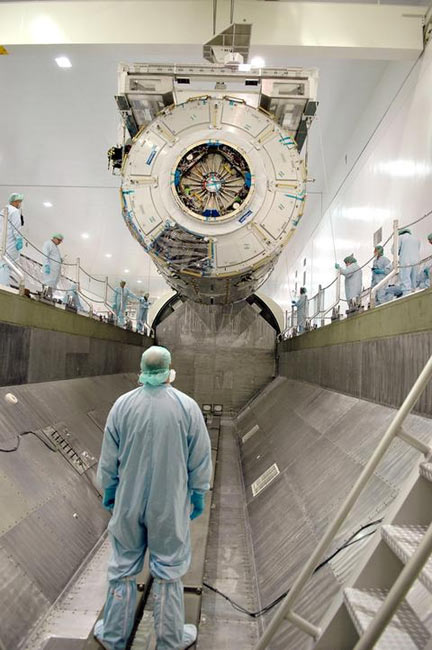Shuttle's Retirement May Affect ISS Construction, NASA Chief Says

NASA'slooming deadline to retire its space shuttle fleet by 2010 may complicate plansto complete the International Space Station, according to the agency's topofficial.
NASAAdministrator Michael Griffin said that while completing the ISS is a major goalof both, the agency's return to flight effort and its exploration vision,meeting the challenge by the 2010 deadline may prove difficult.
"We may notbe able to make the exact completion date that we desire," Griffin toldreporters during a recent shuttle update. "But we will complete it."
Retiringthe three remaining space shuttles in favor of a new crew-carrying vehicle is ahallmark of NASA's exploration vision - announced by President Bush in January2004 - which calls for a return of human explorers to the moon, then sendingthem to Mars and beyond. The first steps in that vision are resuming shuttleflights and fulfilling NASA's ISS commitments with its international partners.
"ThePresident, the space policy that we have, is very firm in that the shuttle willretire in 2010," Griffin said. "What we'll do if we don't complete theInternational Space Station by then is look at other means to complete it."
Griffin andother NASA spaceflight officials said the agency will accelerate plans forthe shuttle's successor, dubbed the Crew Exploration Vehicle (CEV), in hopes ofminimizing - if not completely closing - any gap in NASA's human spaceflightcapability. NASA had previously expected the first human-carrying CEV flight noearlier than 2014.
Returningto flight
Get the Space.com Newsletter
Breaking space news, the latest updates on rocket launches, skywatching events and more!
NASA'sspace shuttle fleet has not flown since the Columbia disaster, which led to thedeaths of seven astronauts and the loss of one orbiter during reentry on Feb. 1,2003. Damage sustained at launch, when debris from Columbia's external tankstruck the shuttle's left wing, was cited as the cause of the accident.
Shuttleengineers and managers have spent more than two years revamping the shuttlelaunch system to increase flight and astronaut safety, work that will culminatewith the launch of STS-114 - NASA's first return to flight mission - aboard thespace shuttle Discovery no earlier than July 13 of this year.
Withoutshuttle flights, space station crews have been limited to two members since Expedition 7due to limited supplies. The current ISS caretakers - Expedition 11commander Sergei Krikalev and flight engineer John Phillips - hope to receive athird crewmate, German astronaut Thomas Reiter, who is expected to ride aboardNASA's second return to flight shuttle mission.
RussianSoyuz spacecraft have ferriedcrews to and from the ISS, with automated Russian Progress vehicles deliveringvital water, air and food to the station every few months. But the supply andcrew ships do not have the large cargocapacity of the shuttle, nor can they deliver the large, primary componentsthat will enlarge the station to core completion.
In thepast, NASA was targeting about 28 shuttle flights to reach core completion ofthe space station, but there have been some suggestions that 15 launches, oreven 10, could do the trick, ISS officials have said.
"Thereality is that we don't know how many flights are needed, if we're successfulreturning [the shuttle] to flight," said Michael Kostelnik, NASA's deputyassociate administrator for the shuttle and space station programs, during aspace operations summit earlier this year. "The space shuttle is criticallydependent on what we intend to do with the International Space Station andthose requirements are still being worked out."
Groundedhardware
The absenceof ISS-bound shuttle flights since the Columbia accident has interrupted thelaunch flow of eight station components, which currently sit in a Kennedy SpaceCenter (KSC) facility awaiting their orbiter rides into space, some of whichhave required maintenance due to the extended stay.
In April ofthis year, engineers had to swap out one of six batteries for the station's P4truss segment to prevent it from exceeding its lifetime expectancy beforelaunching into space aboard NASA's STS-115 spaceflight.
Slated fora May 2003 launch before the Columbia accident, STS-115 is now expected to beNASA's third shuttle mission after its two return-to-flight demonstrations -STS-114 aboard Discovery and STS-121 aboard Atlantis.
Otherstation hardware being prepared for launch at KSC include additional trusses theNode 2 module, the Japanese Experiment Module Kibo and the European-built Cupolawhich will eventually serve as the space station's viewport.
Discovery'sspaceflight, commanded by NASA astronaut Eileen Collins, has a launch windowthat stretches to July 31, and NASA officials hope to launch Atlantis on itsSTS-121 mission between Sept. 9 and Sept. 24 of this year.
"Gettingthe shuttle back up there is just going to bring the space station back to itsfull potential," Collins said.
- Fixing NASA: Complete Coverage of Space Shuttle Return to Flight
Join our Space Forums to keep talking space on the latest missions, night sky and more! And if you have a news tip, correction or comment, let us know at: community@space.com.

Tariq is the Editor-in-Chief of Space.com and joined the team in 2001, first as an intern and staff writer, and later as an editor. He covers human spaceflight, exploration and space science, as well as skywatching and entertainment. He became Space.com's Managing Editor in 2009 and Editor-in-Chief in 2019. Before joining Space.com, Tariq was a staff reporter for The Los Angeles Times covering education and city beats in La Habra, Fullerton and Huntington Beach. In October 2022, Tariq received the Harry Kolcum Award for excellence in space reporting from the National Space Club Florida Committee. He is also an Eagle Scout (yes, he has the Space Exploration merit badge) and went to Space Camp four times as a kid and a fifth time as an adult. He has journalism degrees from the University of Southern California and New York University. You can find Tariq at Space.com and as the co-host to the This Week In Space podcast with space historian Rod Pyle on the TWiT network. To see his latest project, you can follow Tariq on Twitter @tariqjmalik.









